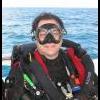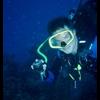Well, I have done two pool sessions and one ocean dive on my Optima rebreather. I am quite happy with the basic unit though there are a couple of minor things I will likely change over time (mostly dealing with low pressure hose lengths, etc.).
Regarding my personal performance, I think that I have set the world record for the worst student my instructor has ever taught. Not only have I made every mistake possible, I am willing to bet that I discovered a few that nobody else has ever done before! Here are some of the highlights (more like low-lights).
Among other things, I started off my first ocean dive under-weighted, and that made things pretty exhausting. I often had to resort to kicking just to keep from blowing up to the surface.
Gearing up, the boat captain helped clip on my bailout (emergency open circuit cylinder) bottle, somehow twisting things up. With so much to do, I didn't notice. My fault, I know. I should have checked if I could delpoy the bailout regulator after. I guess I was so concerned about rebreather related issues that I didn't check the bailout after it was connected.
Underwater, when we went to do our first drill, requiring bailout to open circuit, I was all over the place trying to sort out the mess and deploy my regulator. Of course, this distraction lead to me allowing my PPO2 (partial pressure of oxygen) to start to drop, giving my instructor the opportune moment to show up (Damn that Heads Up Display for giving it away!), yelling at me through the DSV (mouthpiece).
Once I finally sorted out the mess, it took forever to clip the tail of the bottle back onto my Armadillo sidemount setup (a way to attach bailout/emergency dive cylinders to the diver's side that is very streamlined). I didn't seem to have any problems doing this in the pool. However, in the ocean, I was a complete mess. Perhaps I need to lengthen the tail on my bailout bottle a bit more. Add this to the list of things to practice and adjust.
Because we are learning to fly our units manually (they can do everything automatically), we have been instructed to use a setpoint (PPO2 level) that is .2 lower than our actual target. Sounded easy enough. Of course, as it turns out, during the dive, right after I added some O2, our instructor chose that moment to lead us down, under a ledge on the wreck. Alert!: Hyperoxia! Vibrating mouthpiece! I bailout to my open circuit emergency cylinder, flush the loop with diluent gas in order to lower the PPO2, and get things back under control. Next time (there better not be a next time!), I will try flushing without bailing out. After all, it was just a momentary spike. Tuck that lesson into the memory bank.
On the second ocean dive, I added some weight. At least I could finally practice diving the unit without the additional stressor (and distraction) of being underweighted. I ask to just practice diving the unit to get more comfortable diving, maintaining proper buoyancy while also maintaining the PPO2 target setpoint while changing depths on the dive, without doing other drills. Request granted. Things get a little better.
Today, we practiced flooding and clearing the breathing loop in the pool. The flooding part came quite naturally to me.

Actually, we did the drill twice, and I was able to clear the loop pretty well. I was not graceful in carrying out this task. However, I was able to clear the loop without having it even gurgle after. In fact, after the dive was over, I checked, and I would say that there was about a half of a table spoon of water in the water trap in my canister, and there were perhaps four or five (or less) in the counterlung.
Flushing the unit with diluent gas is still a big challenge. Of course, the second I start to add gas, I start to ascend even if I try to vent from my mouth/nose. Today, I did a little better by incorporating hitting the exhaust valve and squeezing the counterlungs. Honestly, it still has not clicked for me on this one yet.
The HUD is an entity that is soooo easy for me to look past in my preoccupation with everything else. Once I do notice it, I have to get my mind used to interpreting the colors and calculating the number of blinks (it uses a little blinking light to signal your status).
I still have a lot to learn about the Hammerhead unit, the rebreather's dive computer system. I haven't used a computer in years (I am used to cutting tables). This will take some time.
Well, my gear is washed, my unit is put to bed, and I am tired. I am still glad I am doing this. I will get it . . . eventually.
Edited by ScubaDadMiami, 23 January 2006 - 12:03 AM.
















